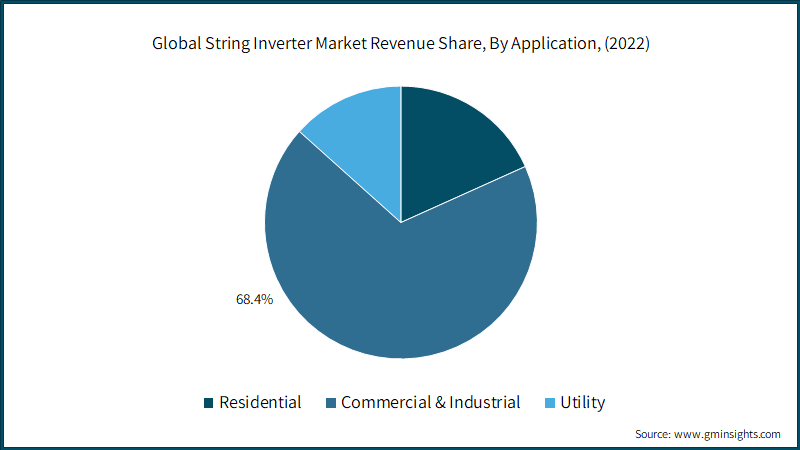Home > Energy & Power > Electrical Equipment > Solar Parts and Components > String Inverter Market
String Inverter Market Analysis
- Report ID: GMI1130
- Published Date: May 2023
- Report Format: PDF
String Inverter Market Analysis
The three phase segment held majority of string inverter market value of over USD 11 billion in 2022. Supportive measures and policies coupled with the consumer engagement in the clean energy transformation will boost the share of renewables in the overall energy mix. Additionally, growing utility scale solar projects owing to the rapid decline in the solar energy costs along with increasing rooftop solar PV deployment in the commercial sector for distributed generation is set to encourage the adoption of three phase inverters.
The standalone installations segment accounted for 16% string inverter market share in 2022. Standalone applications are majorly deployed in regions where there is limited electric grid or the cost of connecting to the grid is high. Policymakers, end users, and private investors have encouraged off-grid solar products as a sustainable and affordable solution for electricity access. Furthermore, off grid solar solutions have played a crucial role in expanding energy access, especially in South Asia and Sub-Saharan Africa, which will positively sway the market expansion.
Stringent mandates across developed economies for low-power residential installations have driven the demand for ≤ 3 kW systems. Increasing awareness regarding environment-friendly systems along with strong regulatory measures to ensure energy security and provision of uninterruptible power will fuel the string inverter market revenue.

Rapid commercialization across developing economies along with the increasing number of 24*7 commercial establishments pose immense expansion potential for string inverter technologies. In addition, solar installations across these commercial establishments provide a reliable measure of energy optimization and cost savings. Henceforth, positive consumer outlook coupled with various fiscal benefits associated with the deployment of solar components will positively influence the string inverter market demand.
The string inverter market from > 600 V systems segment have witnessed a significant growth in 2022, as the adoption of solutions with higher Vdc offer low overall costs. Higher voltage systems allow longer strings, which require less wiring & trenching and fewer combiner boxes, and therefore less labor. These potential savings have increased the adoption of string inverters for 1500 V PV systems. Moreover, the increasing demand from residential consumers on account of expiring FiTs in several countries will boost the low voltage product penetration.

Various government initiatives, expiring feed in tariff (FiT), and clean energy targets have significantly boosted the string inverter market size. For instance, in January 2022, Germany launched the new version of the renewable energy law (EEG), which mandates the deployment of solar for new commercial and residential buildings. Regulators have been continually focusing on decentralized energy storage systems along with PV units through the provision of investment grants. For instance, in December 2021, EBRD provided over USD 11 million loan for the construction of five on-grid PV plant. Furthermore, strong inclination of the industrial sector toward the utilization of non-conventional sources of energy to minimize carbon footprint and reduce the cost of energy conversion is witnessed to further bolster the market penetration

